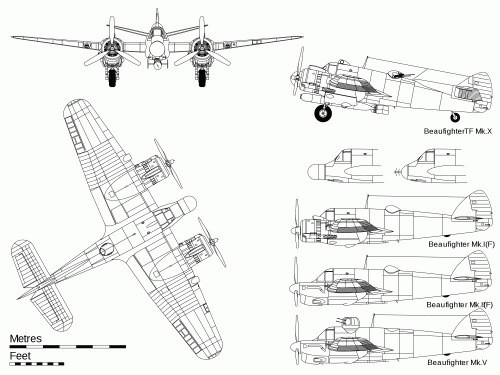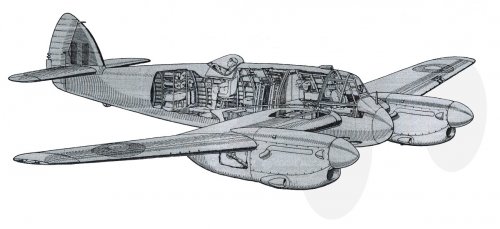Couldn't find a thread on this so here goes:
In March 1938 the Air Staff put together a paper that described an ideal bomber, and then a few months later specification B.19/38 was produced which indicated that the bomber would have a strong defensive armament of eight 20mm “shell-firing gun” (cannon) mounted in to turrets amidships, one above and one below the fuselage, to provide protection above, below and to the aircraft’s rear. On 28 December B.19/38 was revised as B.1/39 and the new document, issued in March 1939, outlined a cruise speed of 451 km/h (280 mph), a minimum range flying at 4,572 m (15,000ft) with 4,082 kg (9,000 lb) of bombs aboard of 4,023 km (2,500 miles), and (at that time) a gross weight of 22,680 kg (50,000 lb). The aircraft was to replace all current heavy and medium bomber types, fabric was not to be used as a wing covering (in other words all Boulton Paul turrets, but in smaller streamlined Bristol-designed turrets).
The favoured powerplant was the Bristol Hercules Radial engine (the Rolls-Royce Griffon was an alternative) and the aircraft had a nosewheel undercarriage and eight internal fuel tanks which, for the 4,023 km(2,500 mile) range requirement, would hold 11,731 litres (2,580 gallons). The 159 could carry a further four fuel tanks on the bomb racks while the maximum estimated range was 5,632 km (3,500 miles) when flying at a speed of 451 km/h (280 mph). Wind tunnel tests with the design showed promise and indicated low drag and good stability, and by spring 1940 the process of structural design had reached an advanced stage.
Fate:
Mock-up dismantled in January 1941 due to great urgency by the outbreak of war.
Bristol 159 - Data
(1939 Brochure Figures or Air Staff Estimates)
Type: Seven-Seat Heavy Bomber
Powerplant: Four 1,500hp (1,156kW9 Bristol Hercules HE.7.SM air-cooled radial engines
Alternative: Four Rolls-Royce Griffon liquid inline engines
Dimensions
Span 34.90 m (114ft 6in)
Length 24.46 m (80ft 3in)
Wing area 167.4m2 (1,800sq.ft)
Weights
Maximum weight
Hercules engines 35,317 kg (77,860 lb); Griffon 34,596 kg (76,270 lb)
Performance
Rate of climb Not Available
Maximum speed: Hercules 486 km/h (302 mph); Griffon 488 km/h (303 mph) both at 4,572 m (15,000ft)
Ceiling
Hercules 7,711m (25,300ft), Griffon 7,224m (23,700ft)
Armament
8 x 20mm cannon; 6,804 kg (15,000 lb) bombs
Source






In March 1938 the Air Staff put together a paper that described an ideal bomber, and then a few months later specification B.19/38 was produced which indicated that the bomber would have a strong defensive armament of eight 20mm “shell-firing gun” (cannon) mounted in to turrets amidships, one above and one below the fuselage, to provide protection above, below and to the aircraft’s rear. On 28 December B.19/38 was revised as B.1/39 and the new document, issued in March 1939, outlined a cruise speed of 451 km/h (280 mph), a minimum range flying at 4,572 m (15,000ft) with 4,082 kg (9,000 lb) of bombs aboard of 4,023 km (2,500 miles), and (at that time) a gross weight of 22,680 kg (50,000 lb). The aircraft was to replace all current heavy and medium bomber types, fabric was not to be used as a wing covering (in other words all Boulton Paul turrets, but in smaller streamlined Bristol-designed turrets).
The favoured powerplant was the Bristol Hercules Radial engine (the Rolls-Royce Griffon was an alternative) and the aircraft had a nosewheel undercarriage and eight internal fuel tanks which, for the 4,023 km(2,500 mile) range requirement, would hold 11,731 litres (2,580 gallons). The 159 could carry a further four fuel tanks on the bomb racks while the maximum estimated range was 5,632 km (3,500 miles) when flying at a speed of 451 km/h (280 mph). Wind tunnel tests with the design showed promise and indicated low drag and good stability, and by spring 1940 the process of structural design had reached an advanced stage.
Fate:
Mock-up dismantled in January 1941 due to great urgency by the outbreak of war.
Bristol 159 - Data
(1939 Brochure Figures or Air Staff Estimates)
Type: Seven-Seat Heavy Bomber
Powerplant: Four 1,500hp (1,156kW9 Bristol Hercules HE.7.SM air-cooled radial engines
Alternative: Four Rolls-Royce Griffon liquid inline engines
Dimensions
Span 34.90 m (114ft 6in)
Length 24.46 m (80ft 3in)
Wing area 167.4m2 (1,800sq.ft)
Weights
Maximum weight
Hercules engines 35,317 kg (77,860 lb); Griffon 34,596 kg (76,270 lb)
Performance
Rate of climb Not Available
Maximum speed: Hercules 486 km/h (302 mph); Griffon 488 km/h (303 mph) both at 4,572 m (15,000ft)
Ceiling
Hercules 7,711m (25,300ft), Griffon 7,224m (23,700ft)
Armament
8 x 20mm cannon; 6,804 kg (15,000 lb) bombs
Source
















